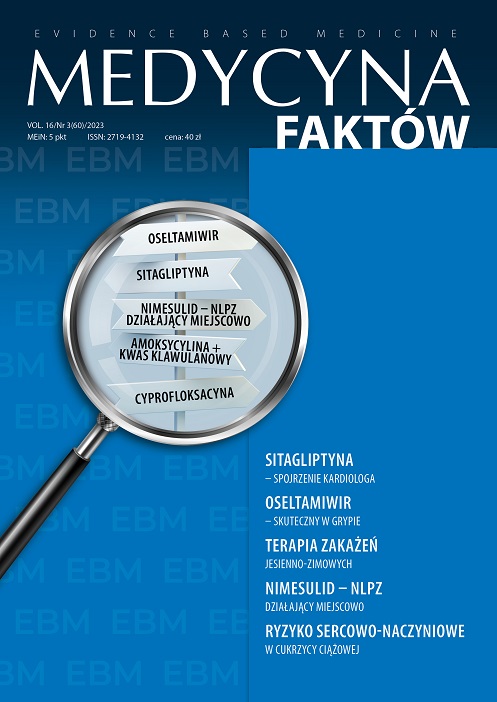What does a cardiologist want you to know about sitagliptin? Review article
Main Article Content
Abstract
Patients suffering from diabetes can develop multiorgan complications including potentially life-threatening cardiovascular ones such as acute and chronic coronary syndromes, cerebrovascular events, chronic kidney disease or diabetic cardiomyopathy. Therefore, correct control of blood glucose levels in diabetic patients should be a priority. Sitaglipitin, a dipeptidyl peptidase 4 inhibitor is a good therapeutic option for patients suffering from type 2 diabetes, including ones with concomitant cardiovascular disease. It exerts a cardioprotective effect through effective blood glucose control, and therefore decreased myocardial fibrosis and hypertrophy as well as through improved lipid metabolism. Sitagliptin has a favorable safety profile because of low risk of hypoglycemia and other adverse events (including weight gain and drug interactions). It is important to note, that the TECOS trial has confirmed its safety in a population of patients with concomitant cardiovascular disease.
Article Details
Copyright © by Medical Education. All rights reserved.
References
2. Sarwar N, Gao P, Seshasai SR et al. Diabetes mellitus, fasting blood glucose concentration, and risk of vascular disease: a collaborative meta-analysis of 102 prospective studies. Lancet. 2010; 375(9733): 2215-22.
3. Tan Y, Zhang Z, Zheng C et al. Mechanisms of diabetic cardiomyopathy and potential therapeutic strategies: preclinical and clinical evidence. Nat Rev Cardiol. 2020; 17(9): 585-607.
4. Deacon CF. Dipeptidyl peptidase 4 inhibitors in the treatment of type 2 diabetes mellitus. Nat Rev Endocrinol. 2020; 16(11): 642-53.
5. Patti G, Cavallari I, Andreotti F et al. Prevention of atherothrombotic events in patients with diabetes mellitus: from antithrombotic therapies to new-generation glucose-lowering drugs. Nat Rev Cardiol. 2019; 16(2): 113-30.
6. Stratton IM, Adler AI, Neil HA et al. Association of glycaemia with macrovascular and microvascular complications of type 2 diabetes (UKPDS 35): prospective observational study. BMJ. 2000; 321(7258): 405-12.
7. Lind M, Bounias I, Olsson M et al. Glycaemic control and incidence of heart failure in 20,985 patients with type 1 diabetes: an observational study. Lancet. 2011; 378(9786): 140-6.
8. Jia G, Hill MA, Sowers JR. Diabetic Cardiomyopathy: An Update of Mechanisms Contributing to This Clinical Entity. Circ Res. 2018; 122(4): 624-38.
9. Ahrén B. Glucose-lowering action through targeting islet dysfunction in type 2 diabetes: Focus on dipeptidyl peptidase-4 inhibition. J Diabetes Investig. 2021; 12(7): 1128-35.
10. Araszkiewicz A, Bandurska-Stankiewicz E, Borys S et al. 2023 Guidelines on the management of patients with diabetes – a position of Diabetes Poland. Curr Top Diabetes. 2023; 3(1): 1-133.
11. Kapłon-Cieślicka A, Filipiak KJ. Inhibitory peptydazy dipeptydylowej 4 w leczeniu cukrzycy typu 2. Choroby Serca i Naczyń. 2012; 9(5): 263-72.
12. European Medicines Agency. Januvia: EPAR – Product Information 2021. (access: 7.07.2023).
13. Green JB, Bethel MA, Armstrong PW et al. Effect of Sitagliptin on Cardiovascular Outcomes in Type 2 Diabetes. N Engl J Med. 2015; 373(3): 232-42.

